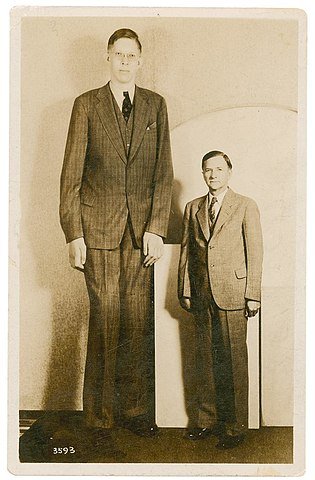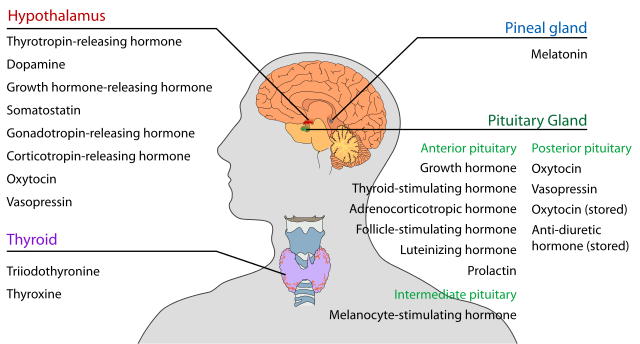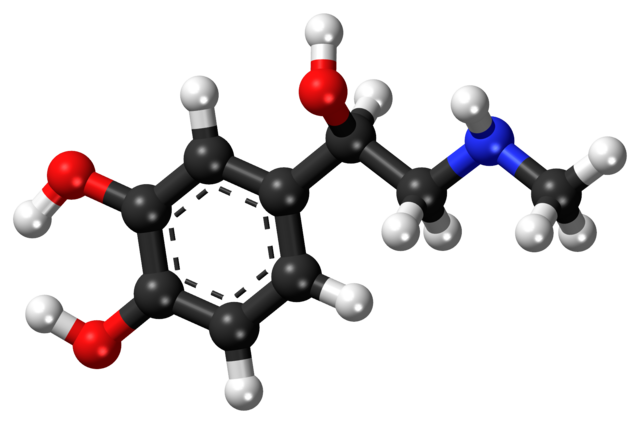HORMONES: Gigantism, Acromegaly, and The Action of Adrenaline, Prostagladins, Endorphins and Pheromones.
Robert
Wadlow, the tallest man who ever lived, had a condition called gigantism; he
probably had a tumour that produced large amounts of growth hormone. The growth
plates in his long bones didn’t fuse as they normally do in the late teens.
Acromegaly
Robert grew to be a touch under 9 feet tall (2.7 metres) and had size 36 feet (US sizes). Born in Alton, Illinois, USA, Wadlow reached the height of over 7 feet at the age of 13 and continued to grow throughout his short life of 22 years. He might have continued to grow, but he died prematurely following an infected foot wound.

Robert Wadlow made it into the record books as the tallest man who has ever lived. There might have been people who have grown taller – stories exist of men over 9 feet tall but their existence, unlike Wadlow’s, cannot be proved. Today, such extremes in size are rare because conditions can be diagnosed early and treated effectively.
But what happens if someone develops a tumour that produces growth hormone later in life, after their growth plates have closed over? Tumours of the pituitary gland that cause excess production of growth hormone are rare, but they do happen. They cause a condition called acromegaly. The name acromegaly comes from the Greek words for ‘extremities’ and ‘enlargement’ and reflects one of its most common symptoms, the abnormal growth of the hands and feet. Soft-tissue swelling of the hands and feet is often an early feature, with patients noticing a change in ring or shoe size. Gradually, bony changes alter the patient’s facial features: the brow and lower jaw protrude, the nasal bone enlarges and spacing of the teeth increases. So, growth still occurs, but this does not lead to a change in height.
The disease does cause problems and is fatal if not treated. Overgrowth of bone and cartilage often leads to arthritis. When tissue thickens, it may trap nerves, causing numbness and weakness of the hands. Other symptoms of acromegaly include thick, coarse, oily, smelly skin; skin tags; enlarged lips, nose and tongue; deepening of the voice due to enlarged sinuses and vocal cords; snoring due to upper airway obstruction; excessive sweating, fatigue and weakness; headaches; impaired vision; abnormalities of the menstrual cycle and sometimes breast discharge in women; and impotence in men. Body organs, including the liver, spleen, kidneys and heart, can also enlarge. This is bad enough, but in the longer term, the most serious health consequences are diabetes mellitus, high blood pressure and increased risk of cardiovascular disease. Patients with acromegaly are also at increased risk for polyps of the colon that can develop into cancer.
Acromegaly is difficult to diagnose as the changes it brings about happen very slowly and can be mistaken for changes that result from the normal ageing process. However, once it is diagnosed, it can be treated and people with acromegaly can avoid the changes in their facial features that were common until about 35 years ago, when treatment became available. The first treatment is surgery to remove the pituitary tumour – this reduces the production of growth hormone significantly, but perhaps not down to normal levels. The slight excess must then be ‘mopped up’ using drug treatment. The main drugs in use are called octreotide and lanreotide. These are analogues of the hormone somatostatin, which dampens down the production of growth hormone by the pituitary. Early forms of the drug had to be injected under the skin every 8 hours, but longer-acting preparations that last a month are now available. After surgery, a patient is given the short-acting form to judge which dose is most suitable for them, and then they move on to the once-a-month injections, which need to continue for the rest of their life.
Octreotide does have side-effects as it affects the digestive system and pancreas. Use of the drug over a long time can cause diarrhoea, nausea and excess gas. Some acromegaly patients who already have diabetes have experienced a more welcome side-effect – octreotide can reduce their need for insulin and improve blood sugar control. In some people, surgery is less successful than in others, and they may retain more of their original tumour. This treatment lowers growth hormone levels by about 50 per cent over 2 to 5 years, but it also causes a gradual loss of production of other pituitary hormones with time.
No single treatment is effective for all patients and all therapies have their side-effects, which need to be taken into account. Acromegaly is rare and patients receive individual treatments tailored exactly to their requirements, according to their age and tumour size. This is generally successful and the patients can lead normal lives and attain a normal life span.
THE HYPOTHALAMUS AND PITUITARY: PARTNERS IN COMMUNICATION AND CONTROL
The pituitary has been called the ‘master gland’ because it controls the activity of most of the other endocrine glands, but it is itself actually under the control of the hypothalamus. The range of hormones produced by the pituitary and the way the hypothalamus controls pituitary function are shown in the figure below.
The human pituitary gland has a posterior lobe and an anterior lobe. Anterior means ‘towards the front’ while posterior means ‘towards the back’. The pituitary stalk connects the posterior lobe to the brain. This direct physical link allows nervous communication between the pituitary and the hypothalamus. A rich network of blood vessels also links the hypothalamus with the anterior lobe, allowing hormonal signals to pass from the brain to the pituitary.

Endocrine glands in the human head and neck and their hormones. LadyofHats, Public Domain
Neurosecretory cells and the posterior pituitary
A neurosecretory cell is a modified neurone that synthesises a hormone. The hormone is produced in the cell body and is then transported down the axon and released into the blood through the synapse, which terminates on a capillary. The neurosecretory cells that arise in the hypothalamus and end in the posterior pituitary make two hormones: anti-diuretic hormone (ADH) and oxytocin. When the hypothalamus is stimulated by appropriate nerve impulses, it releases these hormones into the posterior pituitary. From here they pass into the blood and then travel around the body. ADH controls the reabsorption of water by the kidneys; oxytocin causes contraction of the uterus during childbirth.
Hormonal control of the anterior pituitary
Blood vessels that connect the hypothalamus with the anterior pituitary carry hormones and chemical messengers. These either stimulate or inhibit the release of pituitary hormones, including growth hormone, prolactin, the gonadotrophins, adrenocorticotrophic hormone and thyroid stimulating hormone.
NERVOUS AND HORMONAL CONTROL OF DIGESTIVE SECRETIONS
The body uses a combination of nerve communication and hormones to control the secretion of digestive juice to coincide with the presence of food in particular areas of the gut. Below is a brief summary of how this happens.
The taste or smell of food encourages the brain to signal the salivary glands and stomach to release saliva and stomach secretions. Food leaving the stomach stimulates the vagus nerve, which then triggers the release of bile and pancreatic juice. Digestive secretions can also be controlled by hormones. The hormone gastrin, produced by the stomach wall, travels in the bloodstream but exerts its effect locally, stimulating the production of both pepsinogen and hydrochloric acid.
Secretin and cholecystokinin control pancreatic and liver secretions. Both are formed by cells in the duodenal wall. Secretin causes the release of sodium hydrogencarbonate in the pancreas. In the liver, it increases the rate of bile formation. Cholecystokinin triggers the release of pancreatic enzymes such as lipase and trypsinogen.
THE ACTION OF ADRENALINE
As the nervous system and the endocrine system are closely linked, we should not be surprised that hormones can affect the way that we feel emotionally. The classic example of this is the fear, fight or flight response.
At the molecular level, adrenaline binds to the outside of a target cell and activates the enzyme adenyl cyclase. This converts ATP to cyclic AMP. Cyclic AMP, is a second messenger which sets off a cascade, a chain of reactions that convert glycogen to glucose. As adrenaline binds to receptor molecules on the surface of a cell, changes in the membrane cause the production of G proteins. For every one molecule of adrenaline that binds, 10 molecules of G protein are produced. Each of those 10 molecules of G protein catalyses the production of 10 molecules of adenyl cyclase. Each molecule of adenyl cyclase stimulates the production of 10 molecules of cyclic AMP. This amplification effect continues along a chain of reactions that eventually breaks down glycogen into glucose.

Ball-and-stick model of epinephrine (adrenaline) molecule. Vaccinationist - PubChem, CC BY-SA 4.0
PROSTAGLANDINS
Prostaglandins are a group of hormone-like compounds. They were originally thought to be produced by the prostate gland – hence the term prostaglandins. They are not true hormones as they are not produced by endocrine glands. Most mammalian cells synthesise prostaglandins, which act locally on surrounding cells.
Prostaglandins control cell metabolism, probably by modifying levels of cyclic AMP inside the cell, and are involved in a wide range of activities including blood clotting, inflammation and smooth muscle activity. Prostaglandins are extremely powerful: one billionth of a gram produces measurable effects.
Prostaglandin pessaries can be used to set off labour in a pregnant woman whose baby is overdue. However, semen is rich in prostaglandins, and some experts recommend to expectant couples the natural alternative of having frequent sex. Also, the prostaglandins in human semen cause muscles of the uterus and oviduct to contract during female orgasm, helping the sperm on their journey towards the ovum.
ENDORPHINS
Endorphins are one of several morphine-like chemical messengers produced in the brain (endorphin = endogenous morphine). These polypeptide molecules mimic the effects of drugs such as morphine and heroin: like prostaglandins, they are involved in a wide range of activities, but their most important role seems to be in the management of pain. It is thought that endorphins bind to pain receptors and so block the sensation of pain. Long-distance runners who run until they collapse do so because abnormally high levels of endorphin block out the acute pain and discomfort.
Endorphins also seem to affect the ‘pleasure centres’ of the brain. Stimulation of these areas provides the intense feelings associated with orgasm. Scientists studying the chemistry of pleasure have shown that pleasurable sensations begin when the hypothalamus releases serotonin. This stimulates the release of endorphins, which turns on the supply of dopamine and simultaneously turns off the supply of GABA (an amino acid that suppresses dopamine). Dopamine stimulates the pleasure centre directly.
Drugs such as heroin work by mimicking endorphins. The brain of an addict stops making endorphins and so withdrawal from heroin results in a sudden lack of endorphin and a build-up of GABA, producing unpleasant withdrawal symptoms.
PHEROMONES AND BEHAVIOUR
Pheromones, sometimes called ecto-hormones, are substances that organisms release into the environment to communicate with members of the same species. Pheromones are small, volatile molecules that spread easily in the environment. They are active in very small amounts: the pheromone of the female gypsy moth causes a response in the antennae of the male moth at concentrations as low as one in a thousand million million molecules.
Pheromones are usually classified according to the type of response they produce:
- Alarm pheromones are produced by bees and ants when attacked. They excite other insects of the same species to swarm around the attacker.
- Sex attractants are released by moths, rats and possibly humans to attract members of the opposite sex. Humans do not have a particularly good sense of smell but there is some evidence that very young babies can recognize their mother by her characteristic smell. Some people also think that sexual partners can also recognize each other using their sense of smell, but there is less evidence to back this up.
- Trail substances are produced by ants to show other ants where to find sources of food.
- The queen substance is produced by the queen bee within a hive to suppress the production of other queens.
SUMMARY
After reading my previous chapter on HORMONES: Insects and their hormone problems and this, you should know and understand the following that:
- There are three basic types of chemical signal: local signals such as histamine, prostaglandins and endorphins; hormones such as insulin and adrenaline; external signals or pheromones. The human endocrine system has four main functions. It controls growth, sexual development and fear, flight and fight reactions. It maintains body homeostasis. Endocrine glands lack a duct: their secretions are delivered directly into the bloodstream. Hormone levels are usually controlled by negative feedback loops.
- There are two basic types of hormone: peptide hormones which are derived from amino acids (e.g. insulin) and steroid hormones which are made from fatty acids (e.g. oestrogen). Peptide hormones bind to receptors on the outer membrane of target cells and achieve their effect via a second messenger such as cyclic AMP. Steroid hormones pass straight through the cell membranes and bind to target receptors inside the cytoplasm.
- There is a close link between the nervous and endocrine systems, shown by the way in which, in the brain, the hypothalamus interacts with the pituitary gland. Adrenaline, the hormone that causes the classic fear, flight and fight response, acts at the molecular level to bring about the production of millions of glucose molecules. Prostaglandins and endorphins are local messengers which affect many different types of cell. Prostaglandins are best known for their effects on the female reproductive system: endorphins are chemicals that influence our perception of pleasure and pain.
Thanks for reading.
REFERENCES
https://en.wikipedia.org/wiki/Robert_Wadlow
https://www.guinnessworldrecords.com/records/hall-of-fame/robert-wadlow-tallest-man-ever/
https://www.hormone.org/diseases-and-conditions/acromegaly
https://emedicine.medscape.com/article/925446-overview
https://en.wikipedia.org/wiki/Acromegaly
https://www.mayoclinic.org/diseases-conditions/acromegaly/symptoms-causes/syc-20351222
https://en.wikipedia.org/wiki/Hypothalamus
https://www.ncbi.nlm.nih.gov/books/NBK279126/
https://en.wikipedia.org/wiki/Posterior_pituitary
https://courses.lumenlearning.com/suny-ap2/chapter/the-pituitary-gland-and-hypothalamus/
https://en.wikipedia.org/wiki/Anterior_pituitary
https://courses.lumenlearning.com/suny-ap2/chapter/the-pituitary-gland-and-hypothalamus/
https://courses.lumenlearning.com/boundless-biology/chapter/digestive-system-regulation/
https://www.sciencelearn.org.nz/resources/1836-hormonal-control-of-digestion
https://opentextbc.ca/biology/chapter/15-4-digestive-system-regulation/
https://www.sciencedirect.com/topics/chemistry/adrenaline
 , Public Domain
, Public Domain
As expected, great content that makes it relatively easy for laymen to understand complex biological systems.
Thanks!
Thanks for coming, @valued-customer. I'm glad you found my article easy to read and understand.
A very complete and easy to understand article thanks for sharing.
Thank you for the beautiful comment, @dra.karina.
This post has been voted on by the SteemSTEM curation team and voting trail. It is elligible for support from @curie and @minnowbooster.
If you appreciate the work we are doing, then consider supporting our witness @stem.witness. Additional witness support to the curie witness would be appreciated as well.
For additional information please join us on the SteemSTEM discord and to get to know the rest of the community!
Thanks for having used the steemstem.io app and included @steemstem in the list of beneficiaries of this post. This granted you a stronger support from SteemSTEM.
Hi, thanks for the post! I included a link to it in my daily Science and technology digest, and you'll get a 10% share of that post's rewards.